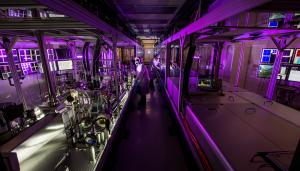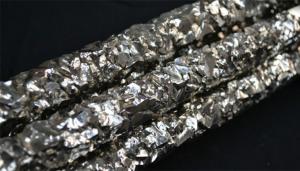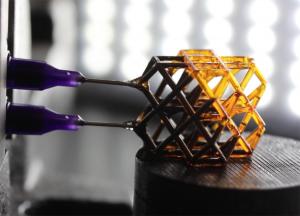LAB REPORT
Science and Technology Making Headlines
Jan. 25, 2019


The High-Repetition-Rate Advanced Petawatt Laser System, developed at Lawrence Livermore, is one example of a technology transferred from lab to industry. In this case, it was a government facility: The Czech Republic’s Extreme Light Infrastructure facility.
One foot out the door
Licensing, spinoff, and Cooperative Research and Development Agreements from the DOE labs are hardly new, but they are receiving new attention and emphasis from an administration that hasn’t always been known for its friendliness to science and research.
Just last year, DOE allowed the labs the authority to use a new mechanism, the Agreement for Commercializing Technology (ACT), in performing R&D for industry and other outside entities.
Lawrence Livermore National Laboratory used an ACT for a $50 million pact with the Czech Republic’s Extreme Light Infrastructure facility to build a high-average-power petawatt laser beamline. Rich Rankin of Livermore’s Innovation and Partnerships Office says the European Union, which funded the Czech user facility, couldn’t abide by standard U.S. legal provisions. Because of the ACT, it no longer needed to.
Through CRADAs with Livermore, the Metal Improvement Company, now known as Curtiss-Wright Surface Technologies, developed a laser-peening process that can be used to prevent metal fatigue and extend the lives of jet fan blades. Some 100 000 blades have been processed and have saved the aviation industry billions of dollars. The two Lab researchers who developed the technology left to become employees of the company.
“It would be great if the American people had a concept for the number of things that have come out of the national labs,” Rankin said. Many of the improvements to auto fuel efficiency, medical instrumentation, the internet and cybersecurity are byproducts of work performed for the government, he noted.


LLNL scientists have revealed how a radioactive isotope of the element zirconium is 100,000 more likely than expected to absorb any room-temperature neutron it encounters.
Capturing a neutron
The probability that a nucleus will absorb a neutron is important to many areas of nuclear science, including the production of elements in the cosmos, reactor performance, nuclear medicine and defense.
New research from a team led by Lawrence Livermore National Laboratory scientists reveals that the radioactive isotope zirconium-88 (⁸⁸Zr) is 100,000 times more likely than expected to absorb any room-temperature ("thermal") neutron it encounters.
Zirconium-88 is a particular type, or isotope, of zirconium, distinguished by the number of neutrons it contains. Typical zirconium contains about 50 neutrons, but ⁸⁸Zr, which is radioactive and not found naturally on Earth, has fewer than normal, with 48 neutrons.
The finding is significant because it showcases how little is known about how radioactive isotopes interact with neutrons, as well as implications for ⁸⁸Zr in national security missions.


New research suggests snowpack loss in the Sierra Nevada will fast-track in the coming decades.
Snowpack melt is steady, but not for long
A recent study by Lawrence Livermore and led by an Oregon State University scientists has found that changes in the atmospheric circulation since the 1980s have offset most of the impact of global warming on winter snowpack in the mountains of the Western United States.
The observed circulation changes are driven by natural fluctuations in sea-surface temperatures in the Pacific Ocean, and are unlikely to last much longer, meaning an accelerated decline in winter mountain snowpack over the next few decades.
The team found without the contribution from natural variability, the Western U.S. would have experienced a much larger decline in winter snowpack, especially in the Cascades and Sierra Nevada.


LLNL researchers and collaborators find that technological advances for game engines and cloud architectures are fueling the development of next-generation wargames that can increase insights for policymakers.
Signaling nuclear deterrence
Through a collaborative project, called the Project on Nuclear Gaming (PONG), UC Berkeley, Sandia National Laboratory and Lawrence Livermore have developed a game called SIGNAL, which serves as a first example of the large-scale, experimental gaming approach for examining nuclear deterrence and conflict escalation dynamics.
The SIGNAL game provides a flexible gaming environment that can be used to study a variety of research questions and simulate some aspects of warfare. The platform also allows for large, quantitative analysis of game outcomes in a multi-player context, tracks demographic data and automatically collects player and game data in real time.
“What we’ve built is a digital online game that is explicitly designed to allow researchers to vary key characteristics that are theorized to influence conflict escalation and warfare,” said Andrew Reddie, a research associate at LLNL’s Center for Global Security Research, adding that the PONG team’s goal is not to replace other types of wargames, but to add another tool to the toolkit.


A new class of Lab-developed metamaterials employ a viscous, magnetically responsive fluid that is manually injected into the hollow struts and beams of 3D-printed lattices and eventually stiffens the fluid and lattice. Photo by Julie Mancini/LLNL.
Stiff as a board
A team of researchers at Lawrence Livermore has created a new class of metamaterials that can be put inside 3D printed structures and nearly instantly (less than a second) respond and stiffen when exposed to a magnetic field — a development that could be applied to next-generation protective gear and a host of other innovations.
The so-called “field-responsive mechanical metamaterials” (FRMMs) use a viscous, magnetically responsive fluid that is manually injected into the hollow struts and beams of 3D-printed lattices. Unlike other shape-morphing — or “4D-printed” — materials (the fourth dimension being time), the overall structure of the FRMMs does not change. The fluid’s ferromagnetic particles inside the part form chains in response to the magnetic field and stiffens the fluid and the lattice structure as a result.
“Metamaterials can create mechanical properties that sometimes don’t exist in nature or can be highly designed, but once you build the structure you’re stuck with those properties,” said LLNL engineer Julie Jackson Mancini. “The next evolution of these metamaterials is something that can adapt its mechanical properties in response to an external stimulus. They exist, but they respond by changing shape or color and the time it takes to get a response can be on the order of minutes or hours. With FRMMs, the overall form doesn’t change. The stiffness does, and the response is quick, which sets it apart from these other materials.”





